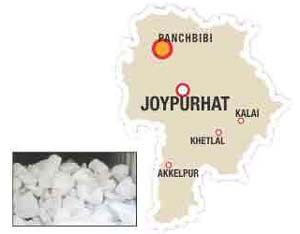The post Largest limestone reserve discovered appeared first on Dhaka Mirror.
]]>The Geological Survey of Bangladesh yesterday discovered a limestone deposit in Panchbibi upazila of Joypurhat.
Moonira Akhter Chowdhury, Director General, Geological Survey of Bangladesh, told The Daily Star that the limestone deposit appears to be the largest discovered so far in the country.
Limestone is a key ingredient for making cement and Chowdhury believes that if the deposit is as big as the indicators are saying, it could meet the demand for limestone in Bangladesh.
 Bangladesh depends largely on imported limestone.
Bangladesh depends largely on imported limestone.“On the basis of scientific indications we can say that this is going to be a much bigger deposit than the old find in Jamalganj of Joypurhat and hopefully, it will also be feasible to mine,” the DG said over the telephone.
She said it was too early to specify the size of the deposit. “It will take one more month to ascertain the total reserve…”
The Geological Survey, which has made most of the coal, limestone, hard rock and peat discoveries in the country since the 1950s, yesterday struck limestone 456.6 metres below the ground. It drilled 5.5 metres further into the layer, which indicated that the layer was thick.
She said as the geologists were drilling deep, they were hoping that the layer would expand more. “The basin seems bigger,” she said.
In the 1960s, the then Geological Survey of Pakistan discovered a large limestone deposit in Jamalganj of Joypurhat. The deposit was between 518.16 metres and 548.64 metres under the ground.
Later, studies revealed that 270 million tonnes of limestone were there and 100 million tonnes of it could be mined.
However, the mine was later deemed financially unviable as the cost to control the underground temperature would have been too expensive and the layer was pretty far below the surface.
Yesterday’s discovery was much closer to the surface.
LIMESTONE IN BANGLADESH
In 1961, the Geological Survey of Pakistan found limestone deposits in Bagalibazar-Takerghat-Bhangerghat area of Sunamganj. The total deposit of around 30 million tonnes was found in four locations at depths between six metres and 100 metres.
At Takerghat, at least 612,371 tonnes of limestone were mined between 1972 and 1993, according to the Geological Survey of Bangladesh.
In the 60’s, limestone deposits were found in Bogra (nearly 2,000 metres below the surface), in Patnitala of Naogaon (300 metres below the surface), Paharpur of Joypurhat (500 metres below the surface) and in Jamalganj of Joypurhat.
In 1966, Fried Krupp Roshtoff of Germany undertook a feasibility study of limestone mining in Jamalganj and found the mine was economically feasible. In 1969 the government undertook a mining project that was never launched.
In 1978, the Geological Survey of Bangladesh came up with a fresh analysis saying that the Jamalganj deposit had 100 million tonnes of mineable limestone covering a 6.7 square km area.
However, the project was abandoned due to the high cost involved in controlling the underground temperature.
-With The Daily Star input
The post Largest limestone reserve discovered appeared first on Dhaka Mirror.
]]>